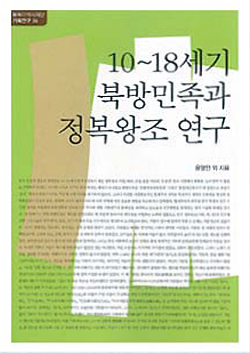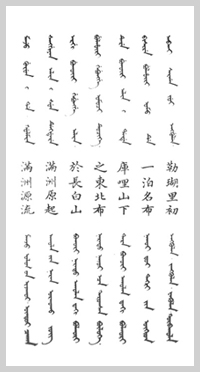NORTHEAST ASIAN HISTORY FOUNDATION 06/2010
-
Peter Yun Professor, Youngsan University

The Northern Races (Khitan, Tangut, Jurchen, Mongol, Manchu) and the conquest dynasties they founded—i.e., Liao, Western Xia, Jin, Yuan, Qing—were often considered "barbarians" that invaded and destroyed advanced neighboring cultures. The northern peoples, drawing on their commanding military power comprising of superior cavalry, built huge empires extending across Inner Asia, including not only China but also Manchuria and Mongolia. Nevertheless, they were seen as having lost their identities, having assimilated into the "advanced" culture of the people(s) they had conquered. Thus, regarded as having been absorbed by China, the Northern Races have come to be considered "ethnic minorities" comprising the "Chinese nation," and their conquest dynasties as stages in the dynastic history of "China."
However, approaching Chinese history from the framework of linear progression or cultural assimilation distorts the nature of the history of the Northern Races and the conquest dynasties. To overcome the Han-centric, present-centric historical perspective of the Chinese academia, there must be a proper and accurate reorganization of the history of the Northern Races and the conquest dynasties.
"Study on the Northern Race and the Conquest Dynasties, 10th-18th Centuries" is the first step toward this endeavor. First, the basic historical sources and studies on the Northern Races in the 10th-18th centuries were organized by time period and region (Korea, China, Japan, and the West). Chinese-language sources are the most plentiful and important historical sources on the northern peoples. However, we focused on non-Chinese-language sources—i.e., those created by the Northern Races themselves as well as those from the Middle East, Europe, and other regions outside what is traditionally East Asia proper–in order to overcome the limitations and biases of Chinese-language sources. For instance, the Mongol Empire is not simply regarded as China's Yuan [元] dynasty; a more macroscopic approach is taken, examining how the Mongol Empire is depicted in Islamic history, by the Western academia, and by Arab scholars of medieval history.
The Northern Races and the conquest dynasties were not mere "barbarians"
The multiethnic empires of the northern conquest dynasties were politically, economically, and culturally different from the centralized dynasties of the Han Chinese. As of late, there have been arguments in Western academia that it is difficult to understand the founding and development of the conquest dynasties founded by the Northern Races from the framework of "Sinicization" or "Chinese history." This trend is especially pronounced in the study of the history of the Qing dynasty on which there is a sizeable volume of historical sources in the Manchu script (滿文). Emerging studies look at the history of the Qing empire not as a period in Chinese history but as an expansive Manchu empire that extended beyond China. Thus, there is call for a Manchu-centered view in examining the cultural linkages within Inner Asia, the "ethnic" diversity in the empire, and the perception of external relations that was different from that of Han Chinese dynasties. Such an approach is to be applied to the empires of the Khitan, Tangut, Jurchen, and Mongol that came before.
In order to incorporate the latest overseas research trends, renowned foreign scholars were invited to serve advisory roles. They include Pamela Crossley of Dartmouth College, a Western scholar spearheading the movement for a new Qing history; Thomas Allen, a U.S. scholar of the history of the Mongol empire; S. Tsolmon, prominent figure in the study of Mongolian history; Kenneth Robinson, who specializes in the history of Joseon-Juchen relations and is currently working in Japan; Temür(特木勒) of Nanjing University; and Professor Erdenee Baatar of Inner Mongolia University. These scholars provided criticisms and opinions on the overall execution of the project and gave direct assistance in the gathering of source materials.
It goes without saying that we must closely follow the research perspectives and trends of China, which has a virtual monopoly over the archaeological artifacts pertinent to the study of the Northern Races and the conquest dynasties. However, it is important to maintain a critical perspective on the research developments in China. At the same time, we must monitor the research trends and findings of Western and Japanese academics while seeking a unique viewpoint that the Korean academia can adopt.
Key to overcoming national histories and realizing a "Northeast Asian history"
 Manchu annals scripted
Manchu annals scriptedby Manchu-Chinese-Mongolian
languages
The numerous references to the history of the Northern Races in Korea's pre-modern historical records testify to our close historical linkages with them. Moreover, given that the primary source materials on the Northern Races and the conquest dynasties are in Altaic/Tungusic languages, there is potential for the Korean academia to develop into a world authority in this research area. The Korean academia should gather relevant source materials and set a research direction based on a critical review and organization of existing studies. In so doing, we should be able to nurture the development of authoritative experts in this field of study and enhance the Korean academia's international authority.
Korean historians tend to make clear distinctions between Korean history, East Asian history, and Western history. There are not many macroscopic studies that transcend these boundaries, and even the studies that do are limited to the history of interstate relations. Against this backdrop, we have either distorted or even completely forgotten the conquest dynasties and the northern peoples—who failed to found modern nation-states—by subsuming their history under Chinese history. In order to move beyond the mere collection of individual national histories—i.e., Chinese history, Korean history, and Japanese history—and realize an authentic narrative of "East Asian history" (and furthermore, world history), we must overcome these boundaries and undertake a comprehensive examination of the history and cultures of the Northern Races and the conquest dynasties.
Such an endeavor will also provide important leads for a critical review of the limitations of the research perspectives founded on modern Chinese nationalism or historical studies that center on the viewpoint of the Han Chinese—e.g., Northeast Project.
The history of the Northern Races and the conquest dynasties is not the history of insignificant "barbarians" that remained in the peripheries of Korean history. This project was limited to a critical review and organization of existing research findings. We hope that there is continued support for further studies by Korean researchers on the history of the Northern Races and the conquest dynasties that do not rely solely on Chinese-language source materials and transcend the framework of Chinese history. Such support and ongoing research will lead to noteworthy findings that will put the Korean scholarly community under the global spotlight.


